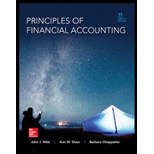
Concept explainers
1.
Identify the maturity date for each of the three notes described.
1.
Explanation of Solution
Notes payable:
Notes Payable is a written promise to pay a certain amount on a future date, with certain percentage of interest. Companies use to issue notes payable to meet short-term financing needs.
Maturity date:
The date on which the borrower should pay the principal amount of loan, or bond, is referred to as maturity date.
| Particulars | Company F | Bank S | Bank C |
| Date of note | 23rd May | 15th July | 6th December |
| Terms of the note ( in days) | 60 | 120 | 45 |
| Maturity date | 22nd July | 12th November | 20th January |
(Table 1)
2.
Identify the interest due at maturity for each of the three notes.
2.
Explanation of Solution
Calculate the interest due at maturity for the note bearing an amount of $4,600.
Therefore, the interest due at maturity for the note bearing an amount of $4,600 is $115.
Calculate the interest due at maturity for the note bearing an amount of $12,000.
Therefore, the interest due at maturity for the note bearing an amount of $12,000 is $400.
Calculate the interest due at maturity for the note bearing an amount of $8,000.
Therefore, the interest due at maturity for the note bearing an amount of $8,000 is $90.
3.
Identify the interest expense to be recorded in the
3.
Explanation of Solution
Therefore, the interest expense recorded in the adjusting entry at the end of 2014 is $50.
4.
Identify the interest expense to be recorded in 2015.
4.
Explanation of Solution
Therefore, the interest expense recorded in 2015 is $40.
Prepare
Explanation of Solution
| Date | Account title and Explanation | Debit in $ | Credit in $ |
| April 22, 2014 | Merchandise inventory | 5,000 | |
| Accounts payable to Company F | 5,000 | ||
| (To record the purchase of merchandise on credit) | |||
| May 23 | Accounts payable to Company F | 5,000 | |
| Cash | 400 | ||
| Notes payable-Company F | 4,600 | ||
| (Paid $400 cash and gave a 60-day, 15% note to extend due date on account) | |||
| July 15 | Cash | 12,000 | |
| Notes payable –Bank S | 12,000 | ||
| (Borrowed cash with a 120-day, 10% note.) | |||
| July 22 | Interest expense | 115 | |
| Notes payable –Company F | 4,600 | ||
| Cash | 4,715 | ||
| (Paid note with interest.) | |||
| November 12 | Interest expense | 400 | |
| Notes payable –Bank S | 12,000 | ||
| Cash | 12,400 | ||
| (Paid note with interest.) | |||
| December 6 | Cash | 8,000 | |
| Notes payable –Bank C | 8,000 | ||
| (Borrowed cash with 45-day, 9% note.) | |||
| December 31 | Interest expense | 50 | |
| Interest payable | 50 | ||
| (Accrued interest on note payable.) | |||
| January 20, 2015 | Interest expense | 40 | |
| Notes payable- Bank C | 8,000 | ||
| Interest payable | 50 | ||
| Cash | 8,090 | ||
| (Paid note with interest.) |
(Table 2)
Want to see more full solutions like this?
Chapter 11 Solutions
Principles of Financial Accounting.
- I need assistance with this financial accounting problem using valid financial procedures.arrow_forwardPlease explain the solution to this general accounting problem with accurate explanations.arrow_forwardI need guidance with this financial accounting problem using the right financial principles.arrow_forward
- Please provide the correct answer to this general accounting problem using accurate calculations.arrow_forwardThe process of transferring general journal entry information to the ledger is called: a. Balancing an account. b. Posting. c. Journalizing. d. Double-entry accounting. e. Balancing.arrow_forwardexplain properly all the answer for General accounting question Please given fastarrow_forward
- Please help me solve this general accounting problem with the correct financial process.arrow_forwardI need help with this general accounting question using the proper accounting approach.arrow_forwardI am looking for the correct answer to this financial accounting problem using valid accounting standards.arrow_forward

 AccountingAccountingISBN:9781337272094Author:WARREN, Carl S., Reeve, James M., Duchac, Jonathan E.Publisher:Cengage Learning,
AccountingAccountingISBN:9781337272094Author:WARREN, Carl S., Reeve, James M., Duchac, Jonathan E.Publisher:Cengage Learning, Accounting Information SystemsAccountingISBN:9781337619202Author:Hall, James A.Publisher:Cengage Learning,
Accounting Information SystemsAccountingISBN:9781337619202Author:Hall, James A.Publisher:Cengage Learning, Horngren's Cost Accounting: A Managerial Emphasis...AccountingISBN:9780134475585Author:Srikant M. Datar, Madhav V. RajanPublisher:PEARSON
Horngren's Cost Accounting: A Managerial Emphasis...AccountingISBN:9780134475585Author:Srikant M. Datar, Madhav V. RajanPublisher:PEARSON Intermediate AccountingAccountingISBN:9781259722660Author:J. David Spiceland, Mark W. Nelson, Wayne M ThomasPublisher:McGraw-Hill Education
Intermediate AccountingAccountingISBN:9781259722660Author:J. David Spiceland, Mark W. Nelson, Wayne M ThomasPublisher:McGraw-Hill Education Financial and Managerial AccountingAccountingISBN:9781259726705Author:John J Wild, Ken W. Shaw, Barbara Chiappetta Fundamental Accounting PrinciplesPublisher:McGraw-Hill Education
Financial and Managerial AccountingAccountingISBN:9781259726705Author:John J Wild, Ken W. Shaw, Barbara Chiappetta Fundamental Accounting PrinciplesPublisher:McGraw-Hill Education





